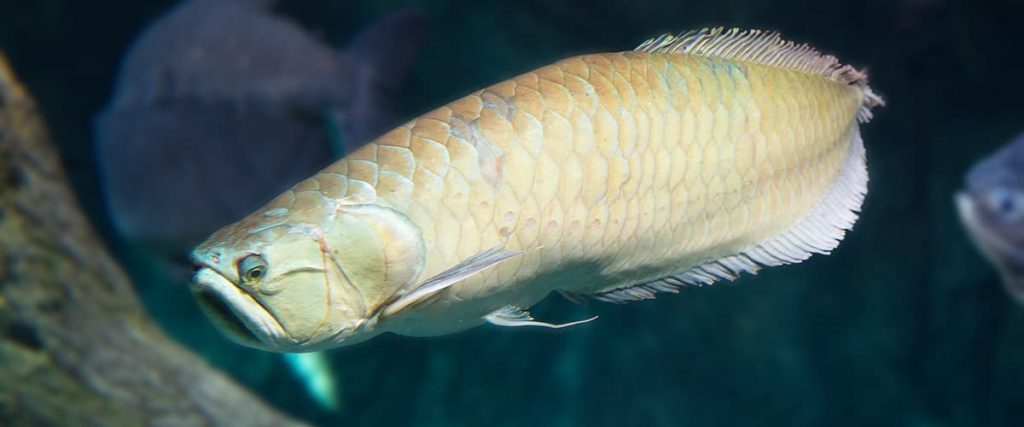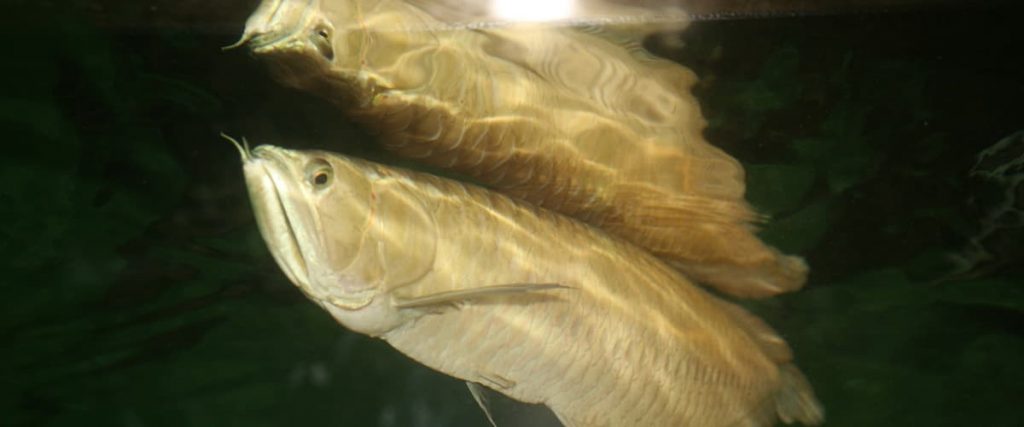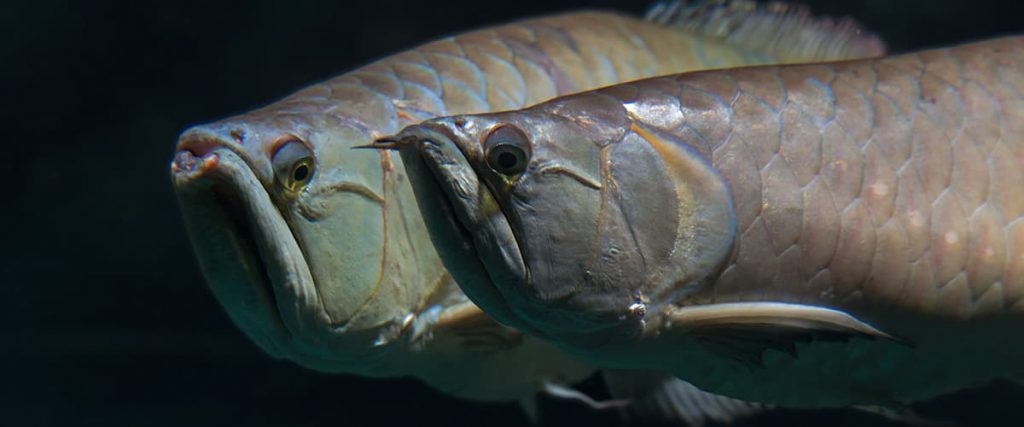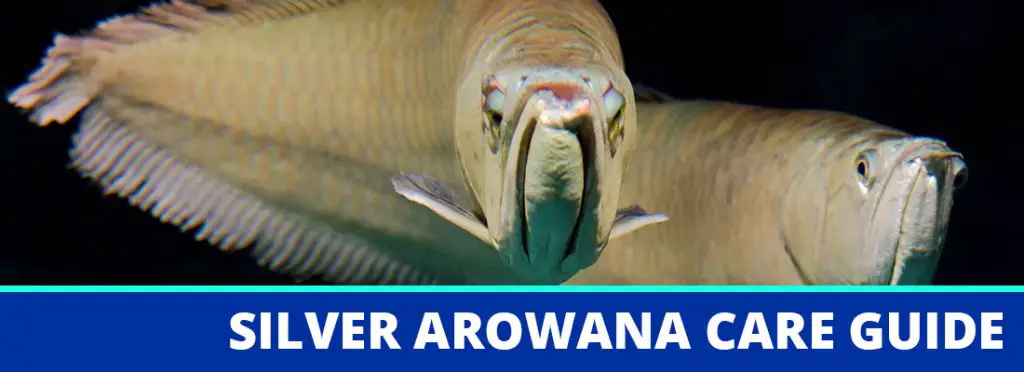In just about every endeavor in life, there are goals and milestones that lead up to something that can take years to achieve.
When it comes to freshwater fish, more than a few people consider the ability to keep Silver Arowanas their ultimate goal.

Quick Intro To Silver Arowana
| Family Name | Osteoglossidae |
| Scientific Name | Osteoglossum bicirrhosum |
| Other Names | Monkey Fish, Dragon Fish |
| Care Level | Moderate to difficult |
| Region of Origin | Amazon River, South America |
| Distant Relatives | Asian Arowana |
| Habitat Type | Fast moving rivers, near fallen trees or other areas where they can hunt animals that land on or very near the surface of the water. |
General Appearance
Long, slim fish with large, silvery to golden pearly colored scales. Their fins and are very compact and close to the body. Unlike many other fish, they have a receding jaw that angles upward at about 45 degrees.
Males vs. Females
Males have narrower, slightly thinner bodies than females. Both have similar coloring that will change over time. Juvenile fish will have a bluish tint to their scales, while older fish may take on green, red, or blue coloring.
How They Move in the Tank
Skittish, but powerful swimmers and powerful jumpers. These are fairly large fish and need a lot of room to swim.
Optimal Water Conditions For Silver Arowana Fish
| Water Temperature | 75 – 82 degrees fahrenheit |
| Water Flow Rate | Very fast |
| pH | 6.5 – 7.5 |
| Hardness | Medium to hard |
| Aquarium Salt (Y/N) | Only for active infections, and as little as possible. |
| Tannins (Y/N) | Yes |
Some aquarium keepers claim this fish will easily tolerate frequent water changes despite the fact that Silver Arowanas have a hard time coping with people simply walking around outside the tank. Imagine what it is like to have all kinds of equipment invading the tank once or twice a month!
Before you try keeping Silver Arowana, make sure that you know how to handle water chemistry needs in ponds or other large tank settings using mostly chemical adjustments.
Tank Setup
| Minimum Tank Size | 500 gallon tank |
| Optimal Tank Size | Heated pond or swimming pool over 1000 gallons. If these fish are kept in tanks that are too small, their bodies can easily become misshapen, or other problems can develop. |
Optimal Tank Shape
Deep and wide with walls about 4 – 6 feet up all the way around the fish tank. Since these fish can leap at least 4 feet out of the water, it is also best to leave several feet of room between the lid and the water to reduce the risk of injury.
Silver Arowana will be more inclined to leap when the tank is too small, however they also do so in order to hunt. You may not be able to curb this fish’s natural leaping tendency.
Best Filter Type
Silver Arowana like a strong water current and enjoy swimming against it, however high capacity filters can damage their gills and cause the gill covers to curl up. This can kill the fish.
Extra Air and How to Provide It
Air curtains with moderate airflow arranged so that the water current in the tank is more horizontal than vertical. You will need several around the tank at all levels.
Testing Schedule First Year
Overall, Silver Arowana have low tolerance for rapid water chemistry changes.
During the first year (never add Silver Arowana to a tank or pond that hasn’t been cycled for at least 1 year), test water bi-weekly for ammonia, nitrites, nitrates, pH, general hardness, and carbonate hardness. Use constant monitoring for oxygen levels.
Testing Schedule After 1 Year
Test water weekly for ammonia, nitrites, nitrates, pH, general hardness, and carbonate hardness. Use constant monitoring for oxygen levels.

Creating the Landscape
| Rocky substrate or gravel | No |
| Sandy substrate | Yes |
| Overhangs and caves | Both. You may also want to have some driftwood leaning into the water to create places where Silver Arowana will look for prey to hunt. |
| Open water | Some |
| Densely planted | No – use carpet plants or small plants along the bottom. This fish needs a lot of room to swim. Open areas are a necessary for all temperaments. |
| Best Plants | Pond plants that provide surface cover to animals this fish may enjoy hunting. Since Silver Arowana may dig in the substrate, keep all rooted plants in pots unless they can tolerate their roots being disrupted. |
| Best Lighting | Bright |
| Best Decorations | Natural plants, driftwood with all sharpness or roughness removed, rounded stones. |
| Decorations to Avoid | As Silver Arowana age, their large scales become loose even from normal swimming and motion. Avoid rough or sharp surfaces that can further damage their scales. |
Physiological Considerations
| Maximum Size | 3 – 4 feet |
| Rate of Growth | Will grow approximately 1 to 1.5 inches per month until they reach full size. |
| Life Span | 10 – 15 years |
| Temperament | Skittish and shy, but predatory to other creatures in the tank |
| Preferred Tank Region | Top |
| Scale Thickness | Large, thick scales that may become loose or fall off with age. Try to avoid using antibiotics not suitable for scale-less or thin scaled fish unless they are specifically safe for Silver Arowanas. |
| Gill Considerations | These fish have fairly small gills that are designed for life in fast moving waters. They can be susceptible to gill flukes and other gill diseases if the water flow is too slow. In addition, slow water may not provide enough oxygen for these fish. |
| Swimbladder Considerations | These are narrow bodied fish that normally move easily from the top of the tank to the bottom. They should not have many swimbladder problems that you would normally see in deeper bodied fish. |
| Fin Shape Considerations | Very small compact fins and tail when compared to body size that make this fish a powerful swimmer and powerful jumper. |

Society
Silver Arowana are tricky at best when it comes to interaction among themselves and with other fish. Males and females are both semi-aggressive and shy. These characteristics will change as the fish age.
For example, while young Silver Arowana may get along fine with Cichlids of the same size, the latter may easily become prey once the Arowana get big enough to consume them. Likewise, keeping Silver Arowana of different sizes in a single tank or pond can be difficult.
- Male to Female Ratio – Since Silver Arowanas begin to pair off as juveniles, it is best to purchase them in established pairs.
- Schooling Behaviors – These fish usually don’t school. Since each fish may have a different temperament, getting a group that works together may be difficult.
- Suitable Tankmates – Fish that are about the same size as Silver Arowana and will also match them in aggressiveness levels. Be prepared for a lot of injuries, however.
- Species to Avoid – When they are younger, avoid predatory and aggressive fish. Silver Arowana are very skittish predators that will fight readily with fish of all sizes. Once they get bigger, small fish will become their prey.
Common Behaviors You May See in Aggressive Silver Arowana
| Changes in Eye Color | No |
| Chasing | Yes. They may also use their long bodies to bash against other species or attempt to do so among themselves. |
| Circling with Fins Splayed | Circling yes, however there is no warning with splayed fins. |
| Fins Splayed as Other Fish Approach or When Approaching Other Fish | No. Silver Arowana are more inclined to bash or face the approaching fish and nip quickly along the other fish’s body. |
| Intensified Colors | Slight |
| Mouth to Mouth Biting | No |
| Nipping | Yes |
Anti-Bullying Solutions That Work Best With Silver Arowana
| Add More Fish of the Same Species | No |
| Add More Males or Females | No |
| Change Feeding Methods, Quantity, or Number of Feedings | Try broadcasting food in different parts of the tank and use smaller, more frequent feedings. |
| Increase Number of Hiding Places | Yes |
| Isolate the Bully | Yes |
| Move Decorations to Shake Up Territorial Boundaries | Yes |
| Move to a Bigger Tank | Yes |
| Water Chemistry or Temperature Changes | No |
Gender, Breeding, and Reproductive Considerations
Silver Arowana usually will not breed in captivity unless you have a big enough tank. They are also inclined to start pairing off as juveniles.
If you are interested in breeding Silver Arowana, it is best to purchase certified breeding pairs rather than take a risk on fish that many not have good genetic traits.
How to Recognize Breeding Pairs
At the juvenile stage, potential pairs will swim close to each other and circle tightly. Later on, as the female gets close to laying eggs, the pair will dig a nest in the sand. After the female releases eggs into the nest, the male will fertilize them, and then carry them in his mouth for almost 2 months.
How Many Babies?
About 20.
Separate Hatchery?
Since these fish are mouthbrooders, you will not need a separate hatchery at first. After the male releases the fry from his mouth, it may be a good idea to partition them off from the parents or other fish.
Special Needs for the Fry
Silver Arowana fry and juveniles usually refuse to consume commercial, frozen, or other non-live foods. Start off with brine shrimp, insects, or any other live food that the fry can hunt and consume.
Later on, you may need to release feeder fish into the tank, larger insects, frogs, or other creatures that are small enough for the growing fish to consume.
Managing the Babies
Depending on their temperaments, fry may or may not continue to get along with each other as they mature. Be prepared to set up additional tanks or add partitions to an existing tank.
Unless you have a lot of space for ponds, it may be necessary to find ways to sell these fish or give them to people that have suitable setups for them.
Nutritional Needs
Even though Silver Arowana get to be fairly large when compared to other aquarium fish, they can be very hard to feed.
These fish are robust hunters that rarely scavenge for food. As a result, juveniles and many adult fish simply cannot or will not adapt to frozen food, flakes, or pellets.
| Wild Foods | Large insects, small fish, frogs, rabbits, or other small animals that get close enough to the water for Silver Arowana to catch. These fish can live outside of the water for several minutes and do not hesitate to jump out of the water to capture prey. |
| How Obtained | Carnivore, Almost exclusively by hunting. |
| How to Replicate | Most people feed juvenile fish by releasing live insects into the tank, feeder fish, or other small creatures such as live brine shrimp. You can also try feeder freshwater shrimp, or other crustaceans. |
| Special Foods for Color and Growth | Depending on the fish’s acceptance, you can try chicken or beef heart and other organ meat. |
| When and How Often To Feed based on Place in Life Cycle | Feed juveniles 2- 3 times per day, and adults 2 times per day. |
Best Sustenance Food
If you want to ensure Silver Arowana have enough to eat without risking infections entering the tank, it will be best to breed your own fish, brine shrimp, and other creatures.
You can choose creatures that will live in the same tank or pond, but keep them partitioned off, and then just release some into the Arowana area at feeding time.
Additional Foods for Optimal Health
Any live insect that doesn’t have venom, poisons, or sharp shells, earthworms, bloodworms, and shrimp. As Silver Arowana get older, they may eventually accept frozen food, pellets, and tropical food sticks.
Finicky Fish Management Troubleshooting Checklist
| Check (and get rid of) Ammonia and Nitrites | Yes |
| Lower Nitrates to Level Suitable for Silver Arowana | Yes |
| Test (and Adjust if Needed) Other Water Chemistry Parameters | Yes |
| Check for Illness | Yes |
| Look for Signs of Bullying Such as Missing Scales, Nipped Fins or other Damage | Yes. Especially watch for bullying around feeding time. |
| Try These Frozen/Thawed or Live Foods | Try live water bugs, frogs, minnows, or worms that swim near the water surface. |
Observe for Possible Environmental Stresses
- Too Much/Too Little Light – increase light
- Sounds – yes – Silver Arowana are very alert to things going on outside the aquarium or pond since they are capable of limited hunting in the air above and land around their natural habitat.
- Vibrations – yes.
- Odors From Air Sprays, Cooking, Construction, etc – yes.
Common Diseases and How to Avoid and Treat Them
Silver Arowana will usually get into fights that lead to injuries. They are also very skittish, which can lead to immune system collapse. These all make Silver Arowana susceptible to common aquarium and pond diseases such as ich, body slime, fin rot, eye cloud, tail rot, and velvet.
How to avoid species-specific diseases
Aside from the more common diseases, there are some others that you will need to watch for:
Anchor worms
Avoid using feeder fish that haven’t been quarantined and treated for these worms. If you notice Silver Arowana darting and scratching (especially in the gill area), treat with an antibiotic suitable for killing anchor worms and fish lice. You will also need to increase oxygen and air flow in the tank, since these worms can reduce gill capacity.
Drop Eye
Fish that are in tanks that are too small will develop stunted growth and other problems. This includes eyes that permanently look to the bottom of the tank.
The best way to manage this problem is to avoid it completely by keeping Silver Arowana in large tanks. It also a good idea to feed them live foods that float along the water surface so that they look up often.
Insofar as treatment, put the Silver Arowana in a tank where it cannot see out from the walls, and must look upward for food.
Best antibiotics: Choose pond safe antibiotics and other medications formulated specifically for Arowanas. In a pinch, you can also try antibiotics that are safe for scale-less fish. Even though this fish’s scales are large and robust, their looseness can be a problem, especially as the fish get older.
Treatments to avoid: Medications not specifically made for Arowanas, or those that have a warning against using them with this fish. In some cases, you may need to take the fish to a veterinarian capable of treating fish diseases.
Food recommendations: Continue using live foods. If the fish tolerates pellets or sticks, see if you can get medicated versions.
Isolation or Hospital Tank? No, however, you may need to know how to isolate and transport the fish to see a veterinarian.
3 Interesting Facts About Silver Arowana
- These fish use the pair of barbels around their mouth as sensory organs to detect prey. As with other fish that have barbels, it is best to avoid gravel or other surfaces that can damage them.
- Silver Arowanas trace their lineage to the Jurassic Era, and look much the same now as they did during the dinosaur age.
- While South American Silver Arowanas are not as heavily regulated as similar species, it is still best to make sure they are legal to keep and breed in your locality.
Where to Buy Silver Arowana
Just about every aspect of caring for Silver Arowanas will require all of your experience in multiple areas of fish care, including cajoling them into eating and managing fairly large sized aquariums or ponds.
That being said, these are attractive, intelligent fish that are well worth the effort you put into taking care of them.


